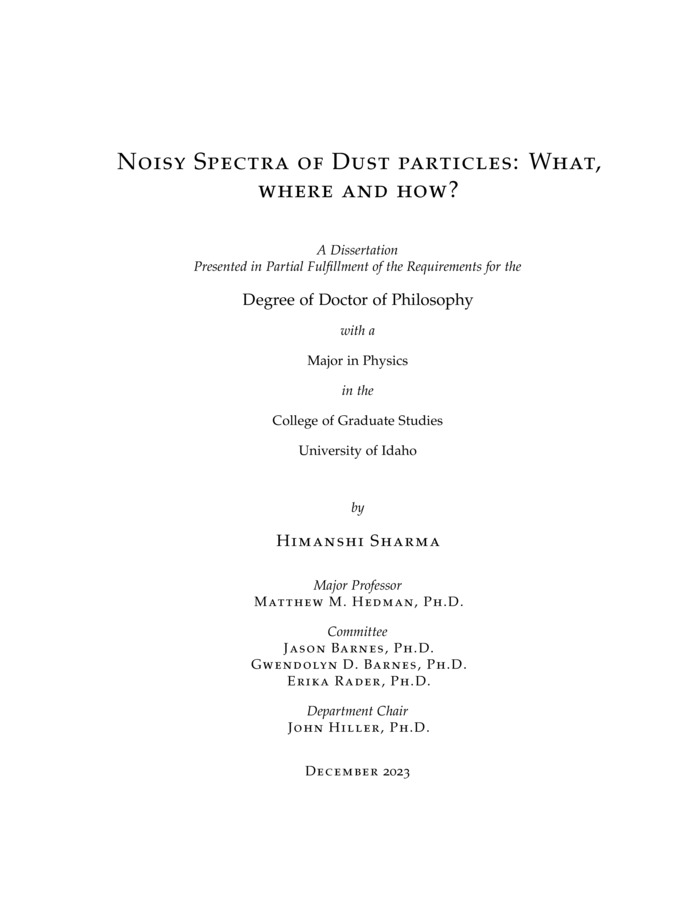Noisy Spectra of Dust Particles: What, Where and How?
Sharma , Himanshi . (2023-12). Noisy Spectra of Dust Particles: What, Where and How?. Theses and Dissertations Collection, University of Idaho Library Digital Collections. https://www.lib.uidaho.edu/digital/etd/items/sharma_idaho_0089e_12736.html
- Title:
- Noisy Spectra of Dust Particles: What, Where and How?
- Author:
- Sharma , Himanshi
- ORCID:
- 0000-0002-0803-2678
- Date:
- 2023-12
- Keywords:
- Dust particles Machine Learning Noisy Spectra Planetary Science
- Program:
- Physics
- Subject Category:
- Physics
- Abstract:
-
Studying the spectra of dust in different planetary environments is important asit provides valuable insights into the processes occurring in various astronomical environments. This knowledge not only advances our understanding of other worlds but also has practical implications for future space missions and our broader under- standing of planetary systems. Spectral data often contains noise and one of the challenges is to reduce this noise and improve the signal-to-noise ratio in order to extract reliable information from the data. We explore and apply several background removal and noise reduction techniques in this study. These techniques are applied on the spectral data of two different dust populations, one on the Earth’s Moon and the second emerging from the south pole of Saturn’s moon Enceladus. First, the dust population on Earth’s Moon is constrained by obtaining an upper limit on the number density of dust particles at the Moon’s surface. Lunar dust, due to its abrasive properties, poses a risk to astronomical observations and the dust densities limits obtained in this analysis will help plan safer and more reliable future missions to the Moon. These constraints on dust population in the terminator region of the Moon can also be used to constrain the Moon’s near-surface environment. Next, we study the properties of ice-grain particles in Enceladus’s south polar plume by deriving typical launch velocities and size distribution parameters for the particles present in the plume. These plume particle properties provide new insights into vent dynamics, suggesting that particle-particle interactions are more relevant than previously expected by established models. We also develop a new Machine Learning algorithm that allows robust constraints on particle size distribution parameters to be extracted from noisy spectral data. These tools reveal that the plume’s particle properties can vary in complex ways over multiple timescales. These findings should constrain the physical processes underlying Enceladus’ plume particle dynamics.
- Description:
- doctoral, Ph.D., Physics -- University of Idaho - College of Graduate Studies, 2023-12
- Major Professor:
- Hedman, Matthew M. Dr.
- Committee:
- Barnes, Jason W. Dr.; Barnes, Gwendolyn D. Dr.; Rader, Erika Dr.; Hiller, John
- Defense Date:
- 2023-12
- Identifier:
- Sharma_idaho_0089E_12736
- Type:
- Text
- Format Original:
- Format:
- application/pdf
- Rights:
- In Copyright - Educational Use Permitted. For more information, please contact University of Idaho Library Special Collections and Archives Department at libspec@uidaho.edu.
- Standardized Rights:
- http://rightsstatements.org/vocab/InC-EDU/1.0/

